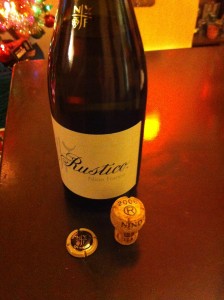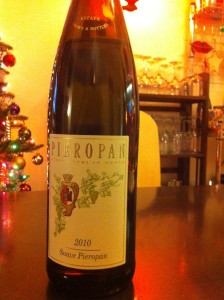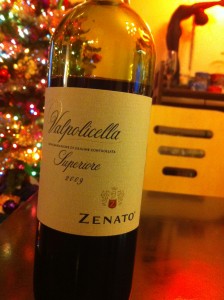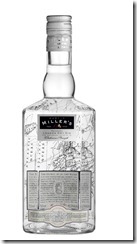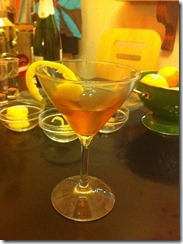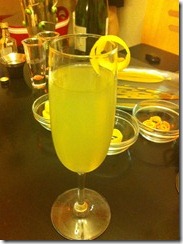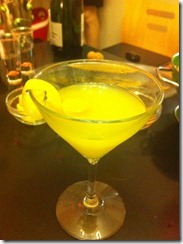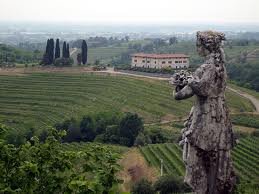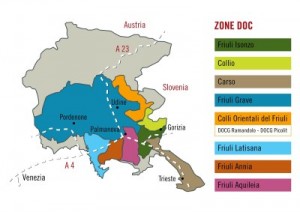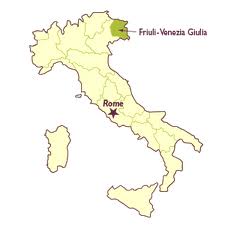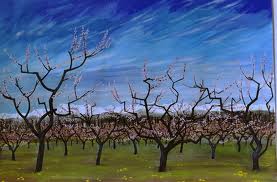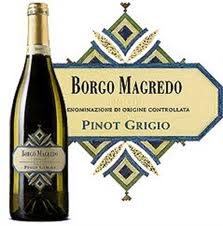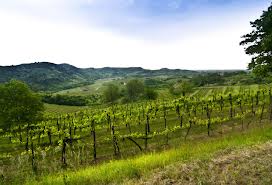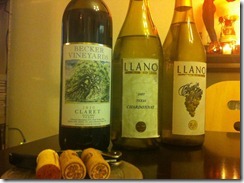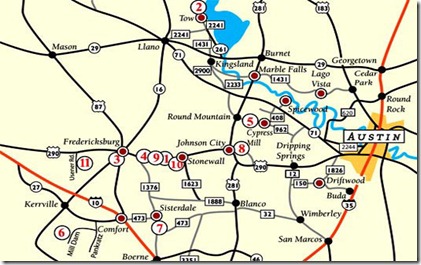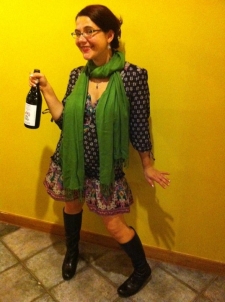This is one area with two heads. Alto Adige is is the northern most part of Trentino- Alto Adige. In fact, until 1919 it was part of Austria’s Tyrol, which is why it is sometimes referred to as South Tyrol or Sudtriol. The area is still predominately German-speaking, and still very German in their wine making and way of life.
This is a viticultural mountain region with the Adige river cutting through it on the way to the Adriatic sea. Vine growing is only possible on river valleys, and in a “Y” shaped growing area called Bolzano, and even then grape growers are in hot competition with apple growers for the land. Only recently have grape growers had the upper hand. The best vineyards, as usual, are on the hills between 600-800m. In recent years there has been much replanting with a focus on quality, and many producers have finally been switching from the traditional pergola training system to, guyot, which has resulted in lesser yields with more intense fruit. Surprisingly a whopping 60% of the wine production from this area is classified as DOC wine. Viticulture is dominated by Co-Ops, to the area’s benefit, as this is one of the few areas where the Co-Ops operate to the benefit of the wine consumer, the grape grower, and the wine maker. They are run with top notch production and managerial ethics.
As far as grapes in this region they focus mostly on Schiva, Chardonnay, Pinot Bianco, & Pinot Grigio on the white end and Lagrein, and Pinot Nero on the red end. Schiva has historically been the grape of this region but it now has fierce competition with its white brethren. There is also a very small DOC zone of Valle Isarco that focus on the more aromatic whites of Silvaner, Muller-Thurgau, and Gewurztraminer (Supposedly native to the town of Traminer here).
Alto Adige, and Trentino are similar in that they have a variety of geographically specific DOC zones together with one general DOC. In Trentino the DOC system consists of one large regional DOC, filled with a variety of variatial specific wines, together with five less geographically specific sub-zones.
Trentino is the southern and principally Italian speaking half of this Northern Alpine growing region. It is also the regional capital. Viticulture is also centered around the valley of the Adige, with a few side valley excursions such as the Valle die Laghi, Val di Cembra. Although the region is pretty far north it is surprisingly warm due to the build up heat in the bottom of the mountains in the summer months. Here the DOC wine trumps Alto Adige at 70%.
As for grapes Trentino mirrors Alto Adige in varietals, while also bringing Merlot, and Lambrusco to the mix. Unquestionably the most important DOC wines of Trentino are 17 varitally labeled wines of crowned on the white end with: Chardonnay first, then Pinot Grigio, Muller-Thurgau, and Pinot Blanc. For reds we see Cabernet, Merlot, Marzemino, Lagrien, and Pinot Noir (Nero).
Yields from the predominately tendon vineyards are too generous to make super-high quality wines, but their major pitfall is being market driven, and trying to make what the “everybody’s drinking” as opposed to what the land is suited to grow. This is slowly changing as Alto Adige has gained praise for its push towards quality in all aspects from the mid-1980’s to now.
This Week’s Wine
Alois Lageder, “Krafuss”, Pinot Noir, Sudtirol, Alto Adige 2005
From: Perman Wine Selections
802 W. Washington Blvd.
Chicago, IL 60607
(312) 666-4417
Cost: Between $35-$45
Wine Maker’s History & Notes
Alois Lagader
History
The most noble grape varieties grown in the best vineyard sites will never produce great wines without the efforts of human beings who recognize their potential, who give them the care and protection they need, and who are able to harvest them with acumen and expertise. At the Alois Lageder wineries, owned and managed by the Lageder family for five generations, this element of human commitment has both a past and a future. We introduce you here to a few of the personalities who in the course of almost 200 years have shaped the character of our wines.
Our story, like so many of those in Alto Adige, has its beginnings in a high, alpine valley. Early in the nineteenth century, a young man from the Himmelreichhof farm –near the village of Albions, at the beginning of the Val Gardena, tied his belongings up into a bundle. The time had come for Johann Lageder to bid farewell to the family farm: he was ready for the path that would take him down into the city of Bolzano, where he intended to stand on his own two feet. He found employment with a wheelwright. Johann possessed both expert craftsmanship and an entrepreneurial spirit, and in 1823 he was able to acquire the workshop. At the same time he also began to deal in wine. In 1855, his two sons divided his worldly belongings between them. The elder son took over the wheelwright shop; the younger son, Alois Johann, inherited the wine trade. He also inherited his father’s entrepreneurial spirit and intended to expand the business, with the purchase of his first vineyard and he began to cellar wines made from the fruit grown on his own properties, as well as from grapes purchased from other growers in the area.
Alois Johann’s eldest son, Alois II, shared his passion for wine and was soon able to purchase other vineyards for the family, in the area of Santa Magdalena, in the northern Bolzano hills. Santa Magdalena was one of the two wines in which he specialized; the other was Lagrein, also from vineyards in the Bolzano area. Alois II was one of the first winemakers to recognize and insist on the importance of site and terroir. He was soundly acquainted with the various microclimates on the slopes surrounding Bolzano and had a keen ability to preserve and underline the subtle differences between them.
This precocious specialist knowledge was once again followed by an heir with an entrepreneurial mind and spirit, Alois III, who thought in even more global terms. He saw the indigenous varietals of Alto Adige to be one of the region’s strengths, and in addition to working with local varieties such as schiava (Vernatsch) and Lagrein, he strove to expand his portfolio. In 1934, he purchased the manor house and vineyards of the Löwengang estate in the village of Magrè, at the southernmost tip of Alto Adige. Here he found what he was looking for: excellent exposures not only for white-wine vineyards, but also for robust red wines such as Cabernet, Sauvignon and Merlot. Deciding that the transport of the delicate fruit harvested took too long by ox cart to Bolzano, he founded a winemaking facility and cellars at the Löwengang estate in Magrè as well as in other wine-producing villages. Before long farmers in the surrounding areas were also supplying him with their grapes. The winery became well established, but Alois’ sudden death in 1963 resulted in a series of sweeping changes.
His designated heir and only son Alois IV was the youngest of six children, and only twelve years old. The challenging task of guiding the winery through the difficult next few years was thus to fall to two powerful and enterprising women: Christiane Rössler, his widow, and his eldest daughter Wendelgard, who at the time was only twenty-one years old. In addition to helping to guide the firm she also became the winery’s public face and representative, no easy task for a young woman suddenly thrust into the center of a business and field dominated by men. She was not, however, someone easily discouraged, and she managed, with the support of the family and especially of her mother, to successfully steer the business along its future course. In 1969 she married the winery’s cellar master Luis von Delleman, who, though young himself had already acquired a wealth of experience in numerous wine-growing regions in Europe. He assumed responsibility for cellar operations, a position he continues to hold today. He soon became well-known as an extraordinary white-wine specialist. The Italian market showed great demand for the fresh, fruity wines of its northernmost region, but most of the wines were still sold in bulk. It wasn’t until the start of the 1970s that the company began more and more to bottle its own wines, and to market them under its own Alois Lageder-label.
The Lageder-family winery was experiencing a difficult time when the current Alois Lageder, after studies in economics and viticulture, assumed leadership of the firm at only twenty-five years old. The image of Alto Adigewines had suffered greatly as a result of years of perception as products for mass consumption. With the support of his sister Wendelgard and of his bother-in-law and cellar master Luis von Dellemann, Alois Lageder undertook the task of repositioning the winery. He was convinced that the region in which he was born had great unexploited potential, and he firmly set a course that aimed strictly for quality. He purchased additional vineyard properties and made use of innovative methods both in the vineyards and in the cellars. He began to trellis his vines on wires, and also reduced their yield.
Inspired by meeting the legendary California vintner Robert Mondavi in 1981, Alois experimented also with the maturation of wines in small oak barrels. Wines such as his red Cor Römigberg Cabernet Sauvignon and his white Löwengang Chardonnay created a whole new style and quality standard on the Alto Adige wine scene. In 1991 Alois purchased the Hirschprunn estate, a renaissance mansion in Magrè with over thirty hectares of vineyards around the village. In 1995 he constructed a high-tech winemaking facility and cellar complex in Magrè, which soon proved to be the precursor of a veritable boom in modern architectural structures at wineries both in Italy and abroad. Since the beginning of the 1990s, he has also blazed a trail of his own in viticulture: today, all of his over fifty hectares of vineyards adheres to the principles of Biodynamic agriculture.
The name Alois Lageder thus stands today no less for tradition than for innovation. In the spirit of a holistic corporate philosophy, Alois IV has also created a permanent place for contemporary art and music at his winery, an innovative move in which he has the support of his wife, the dance-theater choreographer Veronka Riz, and of their three children. His commitments have also extended to spheres beyond his wineries: for over ten years, he was the president of Bolzano’s Museion, Museum for Contemporary Art, and the driving force behind the construction of its new extension, which opened in 2008. At the beginning of 2009, he was elected to serve as the president of Bolzano’s Ecological Institute.
Ideals:
For the creation of extraordinary wines, one also needs something more than healthy, fully-ripened grapes from the best vineyard sites. There is also a need for the right philosophy and for true human commitment. One of our primary goals is to pay attention to the natural properties of our vineyards and to make the best possible use of them. Every location has its own particular merits and characteristics; for every variety of grape, there are particular conditions in which it prefers to grow. We see it as our task to create ideal synergies, supporting nature’s work, thereby taking on the role of “midwives” who facilitate the birth of wines of great elegance, clarity, body, strength, and authenticity.
Biodynamic viticulture emphasizes the specific character of every individual locale and enhances the quality of its wines. Our wines are deeply connected to the landscapes in which they are born. Located between the north and the south, the cool air of the Alps and the warm sun of Mediterranean, the Alto Adige region possesses an enormous wealth of heterogeneous sites, soils, exposures and microclimates. The region has been so generously blessed by nature that it stands out as a template for the production of highly individual wines marked by very distinctive terroir. In order to bring such authentic character to its fullest possible expression, in our vineyards we use the wealth of knowledge about the rhythms and cycles of nature that local farmers have accumulated over centuries. The varying climate and soil conditions of Alto Adige make it especially important to find the most suitable variety of grape for every particular site: at Alois Lageder we have been meeting this challenge for over a hundred and fifty years, and this is the distinguishing feature of our wines.
Our use of modern cellar technology restricts itself to the supportive role of making wines that express the qualities of the grapes from which they are made, which have been grown in harmony with nature. Constantly interacting with these various influences, we constantly pursue the goal of producing wines that reflect our commitment to sustainable procedures in the cellars no less than in the vineyards. Every glass of the wines we produce must tell a story: stories of the vineyard site that grew their grapes, and of the human beings who were their caretakers. Wines that developed in close accord with the natural forces and conditions around them, and which are therefore marked by exceptional elegance, balance, complexity and harmony.
The grapes from the over fifty hectares of vineyards which belong to the Alois Lageder winery are used for the wines of the Tenutæ Lageder assortment. These wines are distinguished by their origin from vineyards that are biodynamically farmed, by the delicate treatment they receive in the cellars, and also, only in selected cases, by maturation in high-quality barriques. This is the path, in close collaboration with nature, which leads to wines of the highest quality. They are flanked by the Alois Lageder assortment: single-varietal wines that are typical of the Alto Adige region and which meet our high quality standards. These wines are made from grapes coming from the best vineyards of quality-conscious growers, some of whom we have worked with for decades. These collaborations are governed by specific cultivation criteria and the ongoing sharing of experiences and information, as well as by mutual respect, all of which contribute to excellent levels of synergy between grapegrower and winemaker.
All of our wines have one thing in common: they stand for the ambition to work in harmony with nature and for knowledge derived from tradition, as well for an open view and courage of innovation. The pleasure of enjoying fine wine always remains the first priority. Alois Lageder aptly remarks, “Our goal does not lie in the production of striking, imposing wines that make a big show of themselves in tastings. Our aim is to offer wines that are more essential and more highly differentiated; wines of which one happily drinks a second glass, and which harmonize with and enhance the enjoyment of a fine meal.”
Vinification
Krafuss Pinot Noir 2005
Viticultural Practices: This wine is made from certified organic grapes from vineyards that are farmed according to biodynamic methods of viticulture (Demeter certification).
Grape variety: Pinot Noir.
Description: medium intense ruby color with a garnet shimmer. Still somewhat closed, clean uplifted varietal aroma: impressions of red berry fruit, cherries along with oak spice (white pepper, cinnamon). Quite pronounced flavor, medium-bodied. Fresh finish with good length and a presence of spicy tannin. Elegant style.
Origin: Krafuss estate vineyard near the village of Appiano-Montagna at an altitude of 1650 ft facing southeast. Loamy, chalky soil (glacial deposit). Cool mesoclimate. The vineyard was planted in 1991 with selected Pinot Noir clones at high density in a wire-trellis system.
Viticultural Practices: this wine is made from certified organic grapes from vineyards that are farmed according to biodynamic methods of viticulture (Demeter certification).
Harvested: 15-16 September 2005.
Yield: 40 hl / ha.
Vinification: fermentation and extended maceration for 18 days in stainless steel tanks. Maturation for 12 months in barriques (Nevers, Alliers and Vosges, 1/3 new).
Alcohol: 13.5% by vol.
Acidity: 4.8 g / litre.
Production: 13,300 bottles.
My Notes
- Appearance:
Clear, Transparent, and Shiny
- Nose:
Healthy
Medium Aromatics of: Black cherries, cinnamon toast, plum skin, cedar, and bacon.
- Pallet:
- Acid: Medium
- Tannin: Medium
- Body: Medium
- Texture: Wet Jersey Cotton
- Finish: Lingering acid, smoke, and tart cherry
- Flavors: round light notes of cherry compote, pork-belly, and toast. Great on its own or with light fatty dishes.
- Conclusion: This is one of the best examples of Italian Pinot Noir I have ever had.
I am pairing it with: Smoked ham & Brie… a great afternoon treat!

